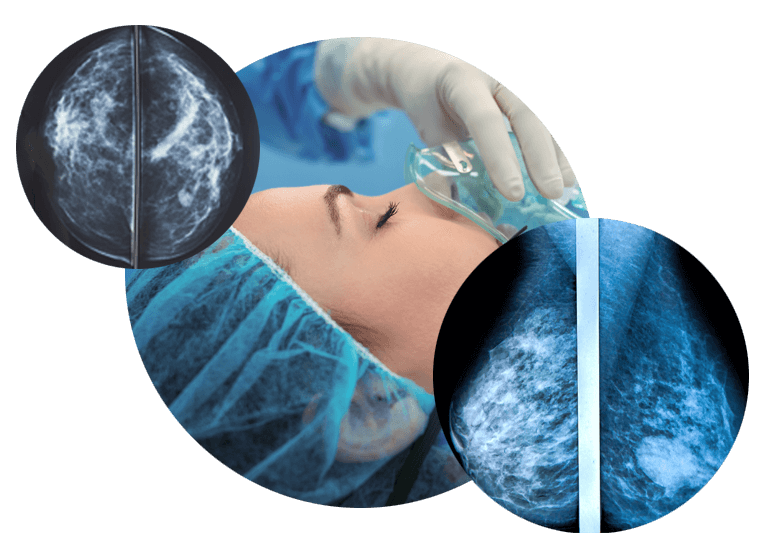Early-Stage Breast Cancer
What are the treatment choices for early-stage breast cancer?
In general, women with early-stage breast cancer need treatment directly to the breast, which is called “local treatment”, and they need treatment to the whole body, which is called “systemic treatment”.
Local treatment is surgery and radiation. Systemic treatment is chemotherapy, hormone therapy and/or targeted therapy.
For surgery, women can often choose between these two options:
- Mastectomy – Surgery to remove the whole breast. Most women who have a mastectomy can also have surgery to reconstruct the breast that is removed.
- Breast-conserving therapy (also called “lumpectomy”) – Surgery to remove the cancer and a section of healthy tissue around it (called a “margin”). Women who choose this option keep their breast. But they usually must have radiation therapy after surgery to kill any cancer cells that might still be in the breast area that is not able to be seen on our breast imaging.
At the same time as they have lumpectomy or mastectomy, most women also have surgery to remove lymph nodes under the arm. Lymph nodes are bean-shaped organs that filter and trap cancer cells. Depending on what kind of cancer a woman has and how far it has spread, she might also need systemic treatment with medicines that can slow or prevent the growth of cancer.
Will my choice of surgery affect how long I live?
No. Studies show that women who choose lumpectomy live just as long as those who choose mastectomy.
Will my choice of surgery affect the chances that cancer will come back?
Yes. Women who choose lumpectomy have a slightly higher chance of having their cancer come back. But if cancer comes back, it can usually be treated successfully.
Is lumpectomy always an option?
No. Lumpectomy is not an option for some women. For example, lumpectomy is sometimes not an option for women who:
- Have more than one tumour in different areas of the same breast.
- Have cancer that has spread throughout the breast tissue and the surgeon can’t get all the cancer out with a margin of normal tissue around it.
- Cannot have radiation therapy, for example because they are pregnant or have certain forms of skin cancer.
- Already had radiation to the area. (Radiation can only be given to an area of the body once.)
- Large tumour in relation to the breast size, which means that the final cosmetic outcome is not optimal.
How do I decide between the two surgery options?
First, make sure you understand all the facts about the different treatment options. Ask your doctor any questions you might have. Then think about how you feel about these issues:
- The way you will look – Is it important to you to keep your own breast? How would you feel if your chest was flat and you had to wear a plastic breast in your bra? Ask to see pictures of women who have had the different kinds of surgery. Remember, women who choose mastectomy can have their breast reconstructed if they want.
- The risk that cancer will come back – Women who choose lumpectomy live just as long as women who choose mastectomy. But women who choose lumpectomy have a slightly higher risk of cancer returning in the breast. Women whose cancer comes back after lumpectomy go on to have a mastectomy.
- The time involved and the side effects of radiation – After lumpectomy, most women must have radiation therapy. This usually involves getting treatments 5 days a week for 3 to 6 weeks, depending on the woman’s age and other factors. This type of radiation will not make you sick or make your hair fall out. But it will tan and possibly even burn the skin on your chest. This burn is like a sunburn and goes away fairly quickly. Toward the end of treatment, radiation can make you feel a little tired, but this is not very common and usually doesn’t last long.
Recovery from surgery
Women who have lumpectomy go home from the hospital the same day as their surgery. For a week or two after surgery, they must rest and avoid sports, swimming and heavy lifting.
Women who have mastectomy stay in the hospital for 1 to 2 days after surgery. If they also have breast reconstruction, they might stay longer, up to 5-7 days. If they go home with drains, that will be looked after by hospital in the home. After about 1-2 weeks, the surgeon takes the drains out in the office. If more fluid or blood builds up after the drains come out, the doctor will drain it with a needle in the office. During the draining process and for a few weeks more, women who have a mastectomy must rest and avoid sports, swimming, or heavy lifting. Even after they recover, women who have mastectomy will not have normal feeling in the chest. Women who have mastectomy can have the breast that was removed reconstructed right away or later.
Regardless of which surgery you have, you will probably need to have biopsies of your lymph nodes. This part of the surgery usually does not cause problems. But in some cases it can cause arm swelling, pain, or stiffness; shoulder pain or stiffness; or a nerve injury. If any of these happen to you, you might need to do special exercises or have physical therapy (work with an exercise expert) to get back to normal.
How do I work with my doctor to make a decision?
Tell your doctor how you feel about the different treatment options. If there is something specific that worries you, tell your doctor about that, too. Then listen to what your doctor has to say about his or her experiences with women who had situations similar to yours. Together you can decide which treatment option is right for you. When you choose your treatment, you can find out more details about that option.

